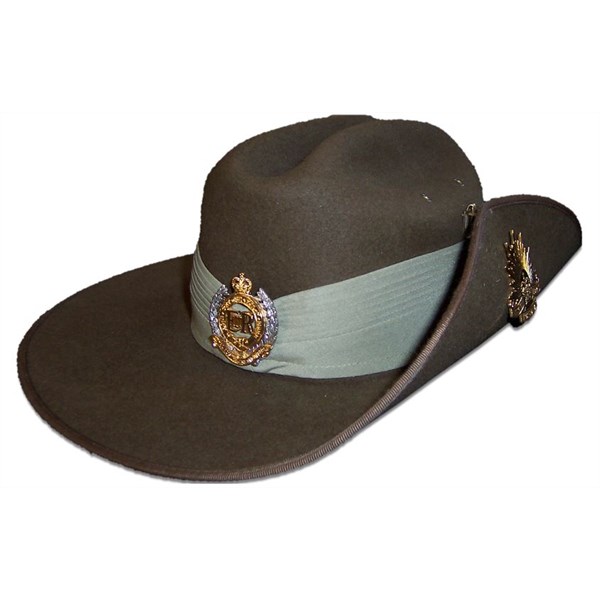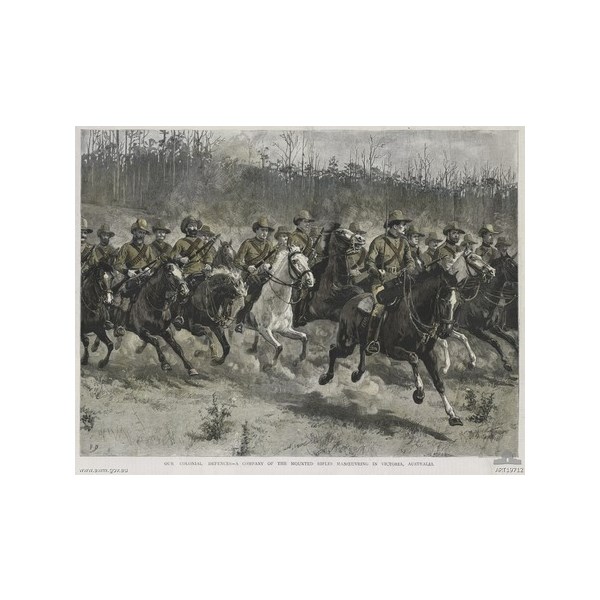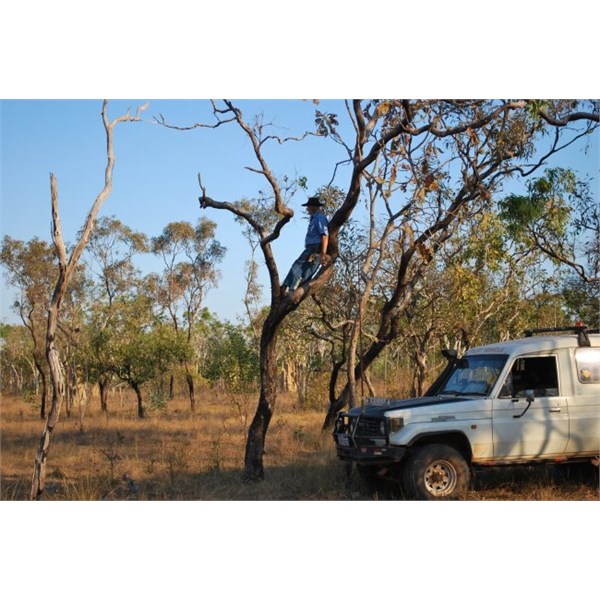Perhaps no other object has been so widely associated with Australian identities as the "slouch" or "digger" hat.
Introduced into Australian military service in the second half of the 19th century, the hat was suited to the local climate and the rigours of military use. In later years it was hoisted on mastheads by victorious troops in place of a flag. More recently it has graced women’s fashions and adorned the heads of athletes and marching squads.

Australian Army Grade 1 Slouch Hat with Royal Australian Engineers corps badge
The slouch hat’s mark in history is rooted in Australia’s introduction to modern warfare at Gallipoli and the reputation established by the AIF on the Western Front. From that time the simple felt hat, with its side turned up, was an emblem of the courage of the Australian digger, and it became a national symbol. Although commonly believed to be uniquely Australian, similar styles of hat were adopted by many other countries, including the
United States, New Zealand, India and even Germany.
The Army refers to the slouch hat by its official designation; Hat khaki fur felt (KFF) - to everyone else it is a ‘Slouch Hat’.
The word ‘slouch’ refers to the sloping brim. The brim is made from rabbit-fur felt or wool felt and is always worn with a puggaree.
History has it that the origins of the Slouch Hat began with the Victorian Mounted Rifles; a hat of similar design had been worn in South Africa by the Cape Mounted Rifles for many years before 1885. The design of the Victorian Mounted Rifle hat originated from headgear of native police in Burma where Lieutenant-Colonel
Tom Price had recognised its value.

A Company of the Victorian Mounted Rifles on manoeuvres in Victoria in 1889.

Colonel Tom Price
The Victorian hat was an ordinary bush felt hat turned up on the right side. The intention of turning up the right side of the hat was to ensure it would not be caught during the drill movement of “shoulder arms” from “order arms”.
By 1890, State military commandants had agreed that all Australian forces, except the artillery corps, should wear a looped-up hat of uniform pattern that was turned up on the right side in Victoria and Tasmania, and on the left side in all other States to allow for different drill movements.
The Slouch Hat became standard issue headdress in 1903 and its brim position was mostly standardised. The slouch hat became a famous symbol of the Australian fighting man during World War One and continued to be worn throughout World War Two. Its use since that time has made it a national symbol.
General Bridges, the first commander of the 1st Australian Imperial Force, was found wearing his slouch hat back to front when he was fatally wounded at Gallipoli. As a mark of respect and remembrance for Bridges, when the slouch hat is worn at Royal Military College - Duntroon, it has become traditional to wear the chinstrap buckle on the right side of the face and the brim down.
This tradition commenced at the Royal Military College in 1932. However, when the slouch hat is worn ceremonially, for example on ANZAC Day, it is worn in accordance with the wider Army custom - brim up and chinstrap buckle on the left hand side.
Today, Army members wear the slouch hat with the brim down to provide additional protection from the sun when not performing ceremonial duties.
The term ‘puggaree’ originates from the Hindu word, ‘Pagri,’ meaning a turban or thin scarf of muslin. Intended for insulation, the puggaree was a traditional
Indian head-wrap, adapted by the British for headdress worn in hot, sunny regions.
During World War One (1914-1918) a plain khaki cloth band was worn and this practice continued until compulsory training was suspended in 1929.
Following the introduction of Voluntary Training in 1930, new puggarees were issued to the Commonwealth Military Force with different coloured folds denoting Arm or Service.

Australian Light Horse troops wearing slouch hats, November 1914.
During World War Two, a flat type of band was issued. Troops who were on active service in the Middle East at the time introduced a folded puggaree as a distinguishing mark of active service.
Later, the Army reverted to various types of plain bands, green dyed puggarees for example, for jungle warfare. However, the official puggaree at the conclusion of World War Two was still the flat band.
The current puggaree has seven pleats, one for each state and one for the Australian Territories. It is made from light khaki coloured cotton and is worn on the slouch hat with a unit colour patch sewn on the right side.
While the majority of the Australian Army wear the light khaki coloured puggaree, there are slight variations for members of the 1st Battalion, the Royal Australian Regiment, and the Corps of Staff Cadets.
Soldiers of the 1st Battalion, the Royal Australian Regiment, wear jungle green puggaree. The dark green puggaree was introduced during the Battalion’s service in Malaya over the period 1959-61. Unable to get puggarees from Australia for an official parade; the task of producing them was given to the Battalion tailor, Mr. Mohavved Beseek. Mr Beseek used ‘bush shirts’ (common issue British field uniform at the time) to make the puggarees as he was unable to obtain the khaki material locally or from Australia.
It is thought that the Commanding Officer, Lieutenant Colonel W. Morrow decided that the green puggaree would be the puggaree worn by the 1st Battalion, the Royal Australian Regiment, in Malaya. After the battalion’s return to Australia, the dark green puggaree was adopted for permanent use. Because the dark green puggaree is so distinctive, the battalion does not wear a colour patch.
Royal Military College staff cadets wear a distinctive puggaree of olive drab colour. The puggaree has eight pleats, with seven representing each state and one for the Australian Territories. The eighth pleat signifies the graduation of the first international cadet through the Royal Military College who hailed from New Zealand.
Slouch hats worn by members of the Armoured Corps are adorned with Emu plumes, a tradition that originated with the Queensland Mounted Infantry during the great shearers’ strike in Queensland in 1891. During this time, the Queensland Mounted Infantry were called out, as soldiers to aid the Civil Power.

Australian Army personel watching a Football match on Mt Bundy Station near Adelaide River wearing slouch hats,

The matching photo 2011 on Mt Bundy Station near Adelaide River and he's not wearing a slouch hat,
After the Second World War there were minor changes to the hat and its continued suitability was questioned, but the slouch style was too deeply entrenched to be replaced. Today, similar felt hats are worn by the all Australian
services, but only the Australian Army, to which it remains a symbol of distinction and pride, continues to wear the khaki felt hat with its side turned up.
As time permitted, the soldiers would participate in a sporting activity where they would ride their horses alongside the emus, plucked the breast feathers, and placed the feathers on their hat. The Gympie Squadron was the first to wear the feathers, a fashion soon followed by the regiment.
The Queensland government permitted the Regiment to adopt the plume as part of its uniform in recognition of its service. In 1915 then Minister for Defence Sir G. F. Pearce granted all units of the Australian Light Horse permission to wear the plume , which they refer to as ‘Kangaroo feathers’.
Emu tufts of approved design and dimensions are now worn by all members of the Royal Australian Armoured Corps as an item of dress. All Royal Australian Armoured Corps personnel were given authority to wear Emu plumes in the slouch hat, brim up or down in 1996, this was extended to all personnel serving in the Royal Australian Armoured Corps Regiment in 2000.
.